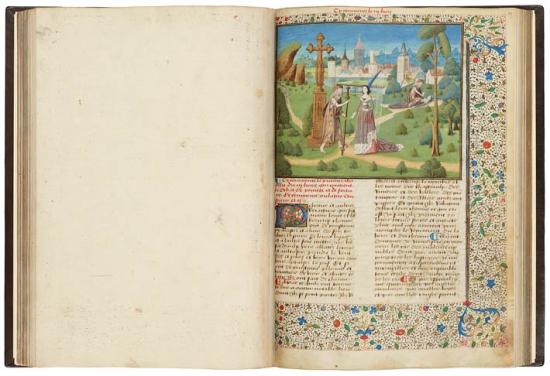
Of Noble Men and Women, in French
Purchased by Pierpont Morgan, 1908
Boccaccio's works were popular in France, appearing in translation in the fourteenth and fifteenth centuries. In the miniature shown here, personifications of Fortune and Poverty meet at a crossroads. Poverty, dressed like a poor pilgrim in ragged clothes, has a walking stick and a hat to which are affixed badges of the shrines she has visited. Fortune is dressed to the nines. Her turret, anchored to her face with a black frontlet, is vertiginously tall. Her narrow-waisted, V-necked gown features ermine at the collar, cuffs, and wide hem. As seen in the right background, the meeting ends poorly.
Late Gothic Vertigo
In the 1460s and '70s fashions reached their Gothic climax. The look for both men and women was tall, long, and lean. Thin was in.
The look for men was dominated by the gown, worn either very short (to the crotch—or barely so) or very long (to the ground). Both versions, accented by a thin belt around a narrow waist, featured high padded shoulders and pleats that flared down over the buttocks and up over the back and chest. These features, developed during the previous decades, brought to a culmination the flatteringly masculine V-shaped silhouette. Pouleines, which accented the lean look, were revived. The chaperon, in fashion for over a hundred years, finally went out of style as new hats–especially a tall, loaf-shaped version—arrived.
Women's gowns continued with their wide V necks, high wasp waist, and long trains. For headgear, temples went out of fashion and were replaced by the turret. This cone-shaped coif, from the tip of which cascaded transparent veils, is perhaps the stereotypical ladies' hat from the late Middle Ages.
